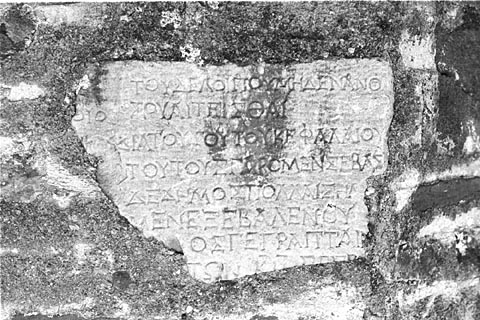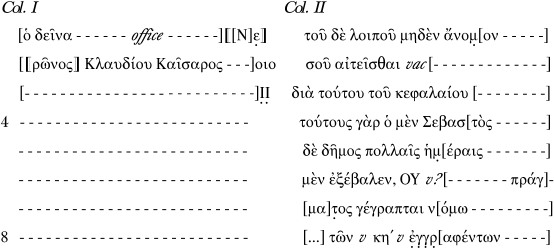| Laconia Survey Inscription No. 7 | |||||||
|---|---|---|---|---|---|---|---|
Subscript of imperial official (?)
Fragment of subscript of imperial official, built into church at monastery of Agioi Saranda (site L534). IG v. 1. 16; SEG 42. 309; N. M. Kennell, 'IG V 1, 16 and the gerousia of Roman Sparta', Hesperia, 61 (1992), 193-202 and pl. 46; LS ii. 216-17, no. 7 and pl. 19 a. (reprinted in SEG 47. 356) 
Digitised photograph of inscription no. 7 
Scanned image of squeeze of inscription no. 7 Greek Text 
Translation (based on Kennell's text and commentary)
"(col. i) [N]e[ro Claudius Caesar? . . .] Kennell's text is for the most part more accurate than that in LS ii. 216-17. In particular, in line 6 the last letter, upsilon, was misprinted as nu in LS, while the first letter of line 7, mu, should have been dotted, as should the sixth, seventh, and eighth (gamma, epsilon, gamma) of line 8 (which Kennell reads as epsilon, gamma, and gamma, all dotted). Kennell restores the name of the emperor Nero in a rasura in lines 1-2 of column i (the rasura can be seen clearly at the top left of our image). In line 3, however, Kennell misses the probable upsilon before the delta; and the last letter of line 8 (which Kennell dots) is certainly rho. The Augustus whose act or judgement is cited in line 4 could be the emperor of that name or a successor. The expulsion mentioned in line 6 probably involved a member of the Euryclid dynasty of Sparta (Kennell 196). The 'twenty-eight' of the last line, rather than being a date (as assumed in LS), is a reference to the twenty-three gerontes and five ephors of first-century AD Sparta. The chief importance of the document, as shown by Kennell, lies in its implicit confirmation that the membership of the Gerousia remained at twenty-three. | |||||||
| Previous | Home | Introduction | Catalogue | Location Map | Next | ||